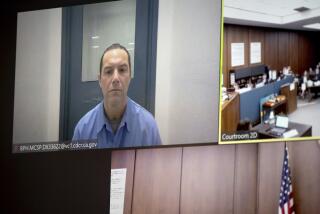Bone Report Disturbs Missing Child’s Family
- Share via
Angered over reports that bone fragments have been identified as belonging to long-missing Laura Bradbury, the grandfather of the Huntington Beach child said Tuesday that the family will seek an independent test to verify the findings.
San Bernardino County Sheriff’s Department investigators telephoned the missing girl’s father, Mike Bradbury, on Tuesday and told him that they had commissioned a sophisticated DNA analysis of skull fragments found in 1986 in the desert. Although Bradbury was told that the tests would not be completed for several days, preliminary results indicate a “match,” Laura’s grandfather said late Tuesday.
“They told Mike, at this juncture, it looks like it’s going to be a match,” Dana Winters said of his son-in-law’s conversation with sheriff’s investigators. Winters remarked that it was the first time since early 1986 that the family had spoken directly with detectives.
The family had expressed anger at the investigators after the first report of the DNA test was aired by a Los Angeles television station Friday evening.
Mike Bradbury told representatives of the San Bernardino County Sheriff’s Department that he would seek a second, independent DNA test, Winters said.
Laura was 3 when she disappeared on a family camping trip to Joshua Tree National Monument in 1984 and became the focus of a nationwide search.
Winters said the family had heard that a Northern California laboratory conducted the DNA tests on the fragments, which were found in March, 1986, about 3 miles from where Laura vanished.
But Ed Blake, a nationally recognized forensic expert, would neither confirm or deny that his company, Forensic Science Associates in Richmond, had done any testing of bone fragments in the Bradbury case. Blake’s firm is one of only three private companies in the nation that do DNA analysis, which is also known as genetic fingerprinting.
San Bernardino County investigators have had custody of the skullcap and other bone fragments since June, 1988, when they “checked them out” of the coroner’s office, according to Coroner Brian McCormick. McCormick said investigators wanted the fragments for “further testing and analysis.”
“All we keep hearing are reports that those fragments are Laura’s,” Winters said. “But nobody, not a single individual involved with this investigation, has called us. Frankly, even if those test results indicate it’s her, we’re not going to be satisfied.”
DNA analysis or print testing in criminal cases is a new, highly technical procedure based on the fact that each person’s DNA, or genetic material, is unique, except in the case of identical twins. Experts in the past have relied on matching blood types, for example, for identifying bodies or linking a suspect with a victim. But it is a process that is far less reliable than DNA analysis.
The DNA print identification test provides for comparisons of genetic codes by extracting the DNA from a crime scene specimen, such as semen, blood or tissue, and chemically dividing it into fragments.
The fragments form a pattern that serves as an identity profile, which can be matched against that of a relative. In the case of Laura Bradbury, the match was against her parents, Mike and Patty. Winters said the Bradbury couple submitted samples of their blood shortly after the fragments were found. Investigators also removed samples of hair from Laura’s hairbrush, which can be examined and compared to test results from the bone fragments.
More to Read
Sign up for Essential California
The most important California stories and recommendations in your inbox every morning.
You may occasionally receive promotional content from the Los Angeles Times.









